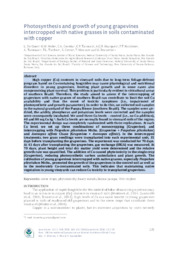Photosynthesis and growth of young grapevines intercropped with native grasses in soils contaminated with copper.
Photosynthesis and growth of young grapevines intercropped with native grasses in soils contaminated with copper.
Autoria: DE CONTI, L.; MELO, G. W. B. de; CERETTA, C. A.; TAROUCO, C. P.; MARQUES, A. C. R.; NICOLOSO, F. T.; TASSINARI, A.; TIECHER, T. L.; CESCO, S.; MIMMO, T.; BRUNETTO, G.
Resumo: High copper (Cu) contents in vineyard soils due to long-term foliage-defense program based on Cu-containing fungicides may cause physiological and nutritional disorders in young grapevines, limiting plant growth and in some cases also compromising plant survival. This problem is particularly evident in viticultural areas of southern Brazil. Therefore, the study aimed to assess if the intercropping of grapevines with native grasses of southern Brazil can contribute to limit the soil Cu availability and thus the onset of toxicity symptoms (i.e., impairment of photosynthetic and growth parameters). In order to do this, we collected soil samples in the natural grassland of the Pampa Biome (southern Brazil). The samples were air-dried, the acidity, phosphorus and potassium levels were corrected and the samples were consequently incubated. We used three Cu levels ? control (i.e., no Cu addition), 40 and 80 mg Cu kg-1. Such Cu levels are normally found in vineyard soils of the region. The experimental design was completely randomized with three replications. At each Cu level, we set up three combinations of monocropping (Grapevine), and intercropping with Paspalum plicatulum Michx. (Grapevine + Paspalum plicatulum) and Axonopus affinis Chase (Grapevine + Axonopus affinis). In the intercropped treatments, two grass seedlings were transplanted into each experimental unit, 35 days before transplanting the grapevines. The experiment was conducted for 70 days. At 41 days after transplanting the grapevines, gas exchange (IRGA) was measured. At 70 days, plant height and total dry matter yield were determined and the relative growth rate was quantified. The addition of Cu caused phytotoxicity in the single crop (Grapevine), reducing photosynthetic carbon assimilation and plant growth. The cultivation of young grapevines intercropped with native grasses, especially Paspalum plicatulum Michx., promoted the growth of the grapevines in the control soil as well as in the moderately Cu-contaminated soils. This indicates that maintaining native vegetation in young vineyards can reduce Cu toxicity to transplanted grapevines. Keywords: cover crops, phytotoxicity, heavy metals, biome pampa, Vitis vinifera
Ano de publicação: 2018
Tipo de publicação: Artigo de periódico
Unidade: Embrapa Uva e Vinho
Palavras-chave: Biome pampa, Copper, Cover crops, Grapevines, Growth, Heavy metals, Native grasses, Photosynthesis, Phytotoxicity, Soils contaminated, Vitis Vinifera, Young grapevines
Observações
1 - Por padrão são exibidas publicações dos últimos 20 anos. Para encontrar publicações mais antigas, configure o filtro ano de publicação, colocando o ano a partir do qual você deseja encontrar publicações. O filtro está na coluna da esquerda na busca acima.
2 - Para ler algumas publicações da Embrapa (apenas as que estão em formato ePub), é necessário ter, no celular ou computador, um desses softwares gratuitos. Sistemas Android: Google Play Livros; IOS: iBooks; Windows e Linux: software Calibre.
Acesse outras publicações
Acesse a Base de Dados da Pesquisa Agropecuária (BDPA) para consultar o acervo completo das bibliotecas da Embrapa.

